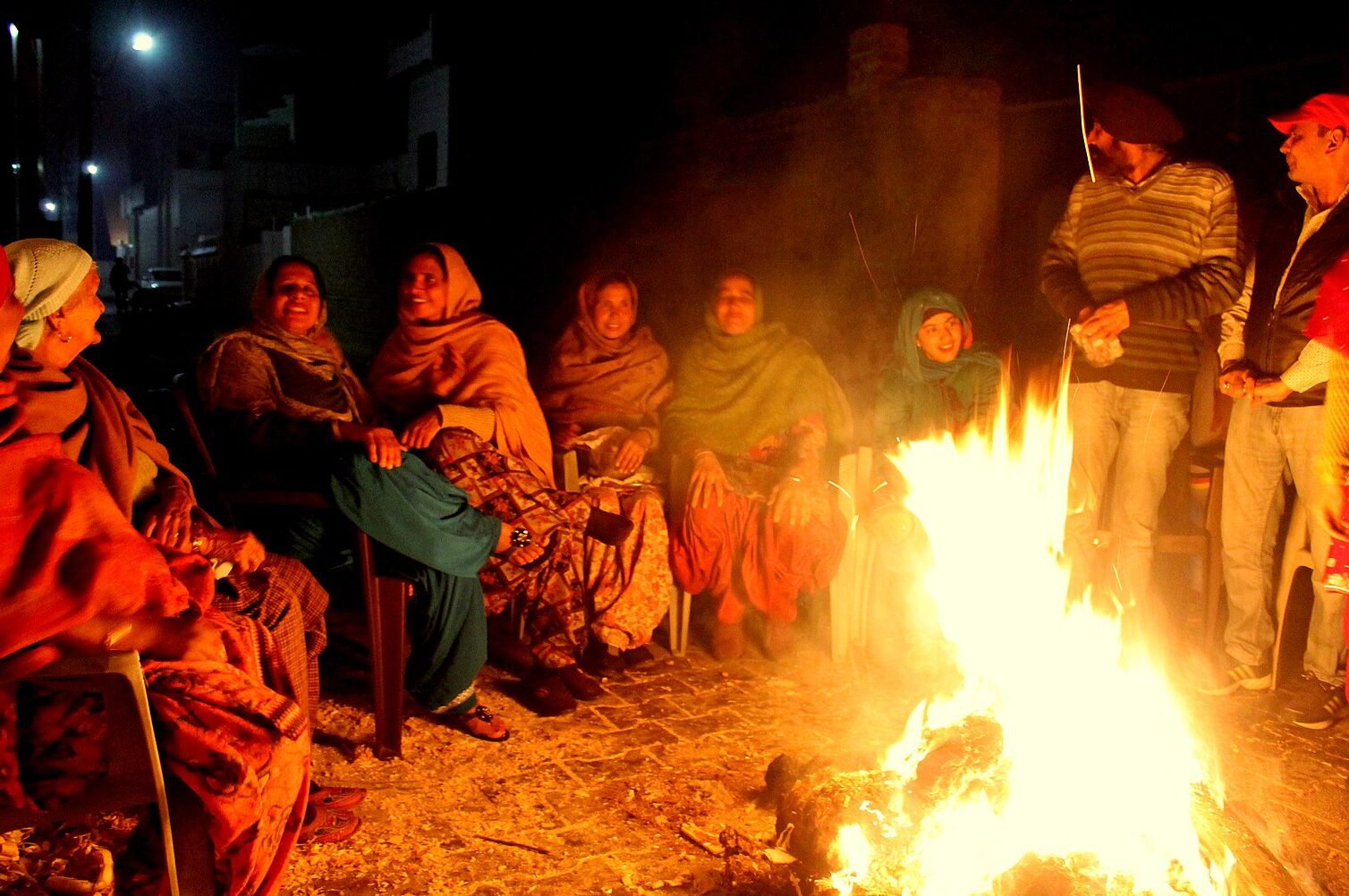
For many Hindus, mid-January is the time for India’s winter harvest celebrations. A seasonal observance that is also religiously significant, the festival is commemorated throughout India under different names. In the northwestern state of Punjab it is called Lohri. In other parts of northern and central India it is known as Makar Sankranti. And in the southern Indian state of Tamil Nadu, it’s referred to as Pongal.
Download our explainer on Lohri, Makar Sankranti, and Pongal.
1) Lohri
Observed by both Hindus and Sikhs in the states of Punjab, Haryana, Himachal Pradesh, and the union territory of Jammu and Kashmir, Lohri traditionally marks the last of winter’s coldest days, and is therefore a festive welcome of longer ones.
For much of India, the winter crops are corn and wheat, which are sown in October. Thus, when the fields start cropping up with little grains in January, Hindus celebrate as a way of giving thanks for the upcoming “golden” harvest.
During the festivities, fires are built to not only keep warm, but also to honor Surya (the sun god) and Agni (the god of fire), in hopes that they will look after the well-being of loved ones.
Representing energy and spiritual strength, fire is a source of rejuvenation and renewal, and is believed to burn away sadness and negativity. Often referred to as the “Bonfire Festival” or the “Festival of Farmers,” this is a time to be thankful and socialize around the fire with festive songs and dances to welcome the arrival of gradually longer days.
Some believe the word Lohri derives from “loh” which is a large iron girdle where Indian breads like chapatis and rotis are made. Lohri hence honors the grain from which these breads are made. Others believe Lohri is commemorated for Dulla Bhatti, who was known as a Robin Hood figure during the time of the Mughal empire, as he stole from the rich and gave to the poor. Legend has it he also saved young women from being kidnapped, and is therefore regarded as a hero.
The day after Lohri is called maghi or maagha, which is the start of the new month and is also known as Makar Sankranti.
2) Makar Sankranti
Referring to the Sanskrit term sankramana, which means “to begin to move,” Makar Sankranti is a solar holiday denoting the northward transition of the sun into Makar (Capricorn) on its celestial path.
Celebrated in honor of Surya and Saraswati (the goddess of knowledge), Makar Sankranti also marks the new year for many Hindus. It is thus considered a very auspicious time, during which observers travel to swim in holy rivers such as the Ganges, Yamuna, Krishna, and Kaveri, as a symbol of rejuvenation and renewal for the upcoming year.
As the six-month period during which the sun travels northward is believed to be highly favorable for succeeding in new endeavors, many take this time to define and set new goals, such as wedding plans, or any Hindu rituals or rites of passage.
The day before Makar Sankranti is called the Bhogi festival. On this day, homes are tidied up and decorated with rangolis (intricate designs hand-laid on the floor with colored powder, chalk, or rice), roads are swept clean, and old items are discarded — sometimes in bonfires, which are also said to ward off negative spirits and energy.
Because Makar Sankranti signifies the end of the harvest season, many Hindu farmers honor the cattle that made such a harvest possible by decorating them with garlands of flowers, painting them with colored powders, and giving them a special feast. Some areas will even hold a parade so that farmers can show off their cattle.
In several of the northern states of India, Makar Sankranti is also known as Uttarayan (uttara meaning “North,” and ayana meaning “movement”). Observers customarily fly kites on Uttarayan, a spiritual metaphor conveying that as one soars and leaps through life, one can remain grounded by a connection to a higher power — generally seen as devotion or attachment to God represented by the kite’s string.
3) Pongal
A four-day festival celebrated especially in Tamil Nadu, Sri Lanka, and Pondicherry, Pongal ushers in the new year with prayers for a good harvest.
In Tamil, pongal translates to “spilling over,” and so the festival derives its name from the tradition of boiling rice in a pot until it starts to overflow. Pongal also happens to be the name of a dish consumed during this festive time, which is sweetened rice boiled with lentils. Celebrations, therefore, often include boiling the first rice of the season with milk and jaggery (a cane sugar).
The first day of Pongal is dedicated to Indra, the king of the gods who brings prosperity to the land through rain. During this time, a special puja is performed, after which the crop of paddy is harvested. The day is also used by farmers to conduct repairs to their equipment, while others perform a ritual called Bhogi Mantalu, in which they rid their house of unwanted items through a bonfire.
The second day is known as Surya Pongal and is dedicated to Surya. On this day, a special ritual is performed where rice and milk are boiled together in a clay pot and tied to a turmeric plant and placed outside as an offering to Surya. Sugarcane sticks, coconuts, and bananas are also offered, and subsequently eaten as sacred food after being blessed.
On the third day, called Mattu Pongal, cattle are honored and decorated with flower garlands and painted with colored powders. The cattle are also bathed, given special food, and sometimes receive a unique blessing from their owner as a way of thanking them for their hard work. Temples are visited, and sometimes processions are held with murtis (image or statue of a deity) adorned in silks and flower garlands on decorative float-like vehicles. People also get together to perform dances or dramas to celebrate the harvest.
The fourth and final day is called Kaanum Pongal. On this day, a ritual is performed where the leftover sweet pongal and other food are set out for the birds to eat. As kaanum means “to visit,” many will set out to see friends, meet with family, and participate in community events and gatherings.
Celebrating Abroad
Even though much of the Hindu diaspora are not directly impacted by India’s harvest, followers still visit Hindu temples, hold pujas, and participate in festivities as a way of maintaining cultural and religious ties from abroad.
While each of these three holidays have their own regional practices, and celebrations vary from community to community, all three festivals recognize the vital role played by the earth, fire, rain, and sun. Earth represents food, fire and rain maintain our health and land, and the sun symbolizes wisdom and spiritual light, ultimately providing life and energy.
Most of the information in this piece is derived from an educational explainer written by Hindu American Foundation’s Director of Education Shereen Bhalla. To learn more about India’s winter harvest festivals, visit her explainer here.









































